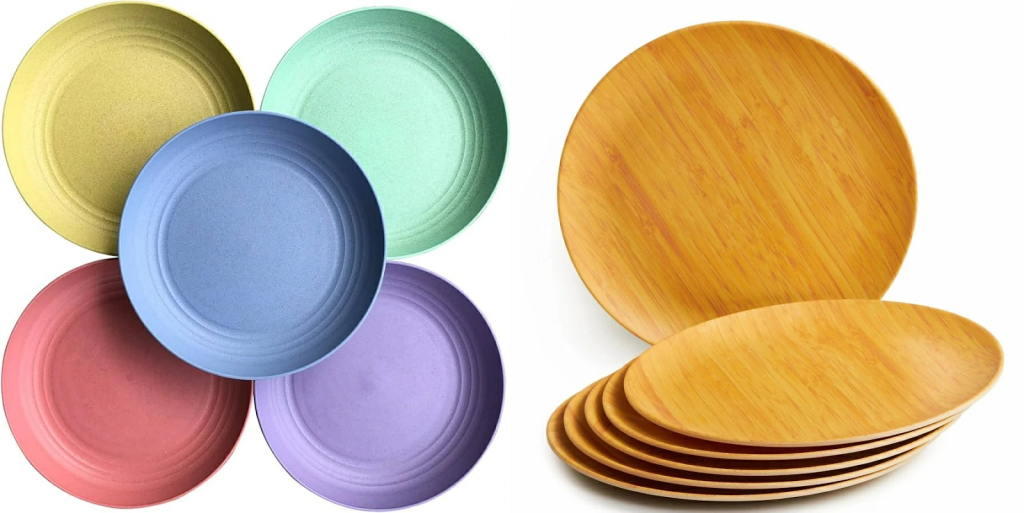Wheat Straw Plates vs Bamboo Plate : Which Eco-Friendly Choice is Better?

As sustainability becomes a global priority, people are shifting to eco-friendly products for everyday use. One of the most common areas of change is disposable tableware. Instead of plastic and styrofoam, environmentally friendly plates made from natural materials are becoming popular. Among these, the debate of Wheat Straw vs Bamboo Plate is quite common. Both options are safe, eco-conscious, and stylish, but they have unique qualities that suit different needs.
What are Wheat Straw Plates?
Wheat straw plates are made from the stalks left after wheat grains are harvested. These stalks are usually agricultural waste that might otherwise be burned, contributing to pollution. By turning them into tableware, manufacturers reduce waste and create sustainable alternatives.
Key Benefits of Wheat Straw Plates
Wheat straw plates are lightweight, durable, and free from harmful chemicals. They are microwave and dishwasher-safe, making them convenient for daily use. Families and students often choose them for their affordability and ease of handling.
Eco-Friendly Value
Since wheat straw is a byproduct, reusing it minimizes environmental damage. These plates are 100% biodegradable and compostable, making them ideal for people committed to a zero-waste lifestyle.
What are Bamboo Plates?
Bamboo plates are crafted from bamboo fibers, a fast-growing and renewable resource. Bamboo does not require pesticides or chemicals to grow, which makes it a sustainable choice. Unlike single-use plastics, bamboo plates provide strength and an attractive natural design.
Advantages of Bamboo Plates
Bamboo plates are sturdy, long-lasting, and naturally antibacterial. They provide an elegant, rustic look that works well for restaurants, events, and eco-friendly homes. With proper care, they can be reused many times, making them cost-effective in the long run.
Natural and Stylish Design
Bamboo plates often showcase their natural texture, offering a premium feel compared to other materials. They are perfect for anyone who values both sustainability and aesthetics.
Wheat Straw vs Bamboo Plate: Durability and Usability
When comparing Wheat Straw vs Bamboo Plate, both offer good durability, but bamboo tends to be stronger and less prone to breaking. Wheat straw plates are lighter and more portable, which makes them great for picnics, kids, and everyday meals. Bamboo plates, being thicker, are ideal for serving heavier foods and for formal dining.
Environmental Impact of Wheat Straw vs Bamboo Plate
Both materials are eco-friendly, but in different ways. Wheat straw plates reduce agricultural waste and decompose quickly, while bamboo plates rely on one of the fastest-growing plants in the world. Choosing between them depends on whether you value waste reduction or renewable resources more.
Composting and Disposal
Wheat straw plates usually decompose faster than bamboo plates, but both are safe for the environment. Unlike plastic, they don’t leave harmful toxins behind.
Cost Comparison: Wheat Straw vs Bamboo Plate
Another factor to consider is pricing. Wheat straw plates are generally cheaper because they are made from leftover materials. They are widely available and affordable for everyday households. Bamboo plates, however, are more expensive but offer a premium look and greater sturdiness, making them a good choice for businesses and events.
Health and Safety
Both options are safe for food use, but there are differences in handling. Wheat straw plates can be placed in the microwave without issue, while bamboo plates should not be used for high-heat cooking. Bamboo’s natural antibacterial qualities give it an extra edge for hygiene-conscious users.
Aesthetic and Lifestyle Fit
If you want colorful, lightweight, and simple designs, wheat straw plates are ideal. If you prefer a natural, elegant, and stylish look, bamboo plates are better. Restaurants, eco-friendly cafes, and households that value presentation often prefer bamboo for its rustic charm.
Choosing the Right Option for You
The choice between Wheat Straw vs Bamboo Plate depends on lifestyle and budget. For everyday, affordable, and practical use, wheat straw plates are a great option. For elegant dining, sturdiness, and long-term reusability, bamboo plates are worth the investment.
Why Choose AnzhuCraft?
When it comes to reliable eco-friendly tableware, anzhucraft.com is a trusted source. AnzhuCraft specializes in bamboo, wood, and paper tableware designed for sustainability and safety. Their products are crafted with attention to durability and environmental responsibility, making them suitable for both households and professional use.
Conclusion
The shift from plastic to natural tableware is a positive step toward protecting the planet. Both wheat straw and bamboo plates offer eco-friendly solutions, each with unique benefits. Wheat straw plates are affordable, lightweight, and microwave-safe, while bamboo plates are durable, stylish, and long-lasting. By choosing sustainable tableware from trusted suppliers like AnzhuCraft, you can make a small but meaningful contribution to a greener future.






